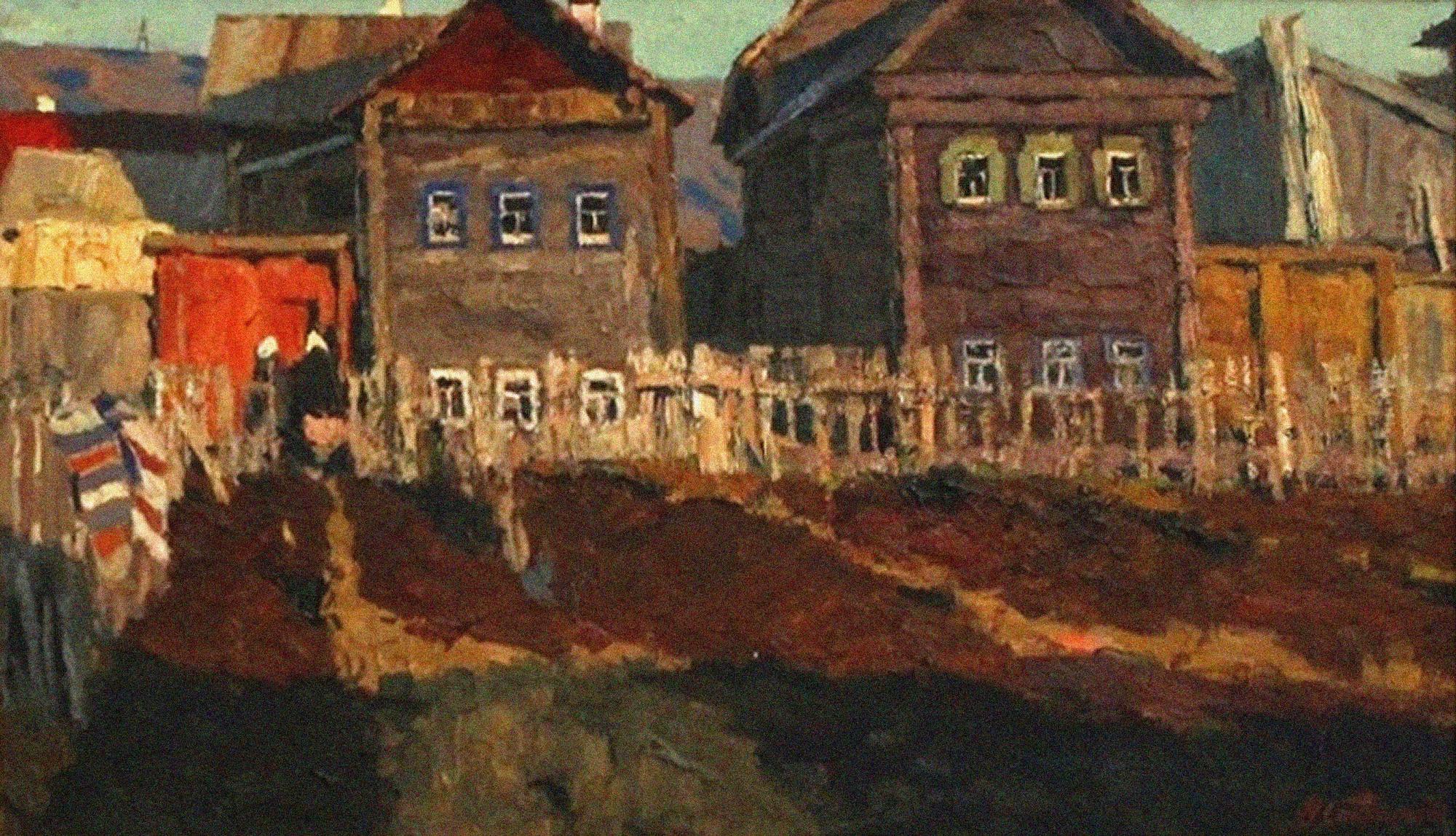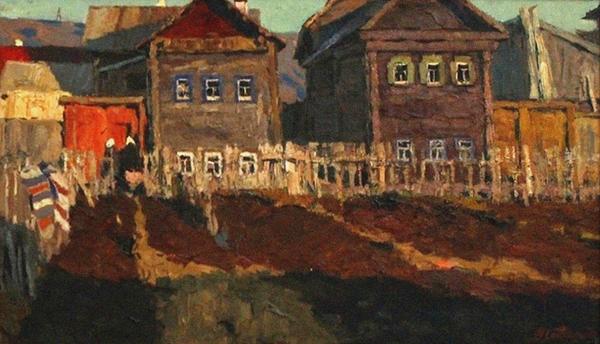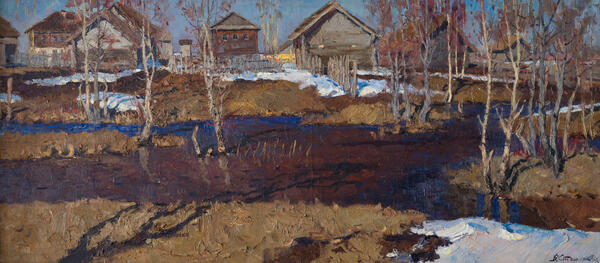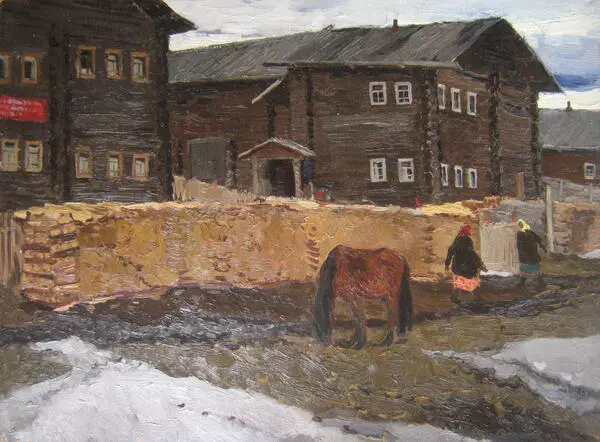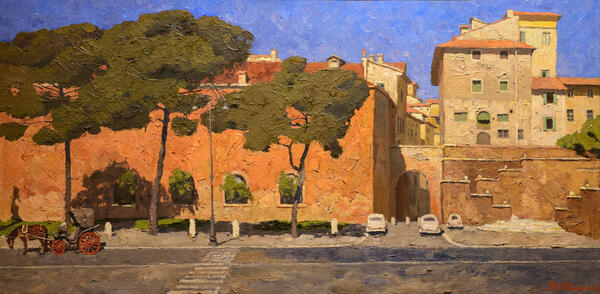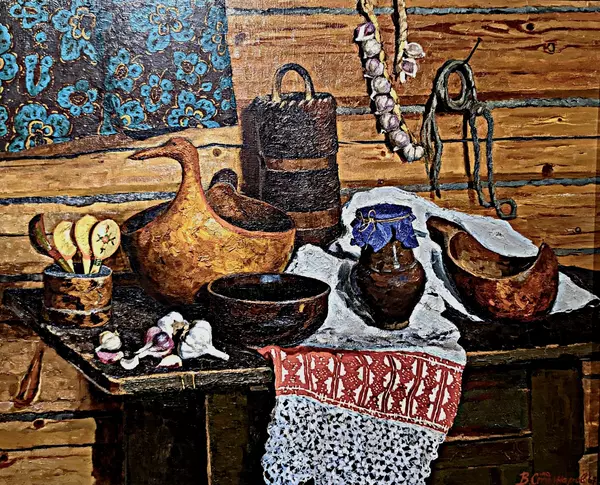Vladimir Fyodorovich Stozharov received an academic artistic education at the V.I. Surikov Moscow Institute, learned from Dmitry Konstantinovich Mochalsky and Georgy Konstantinovich Savitsky.
After he completed his studies his paintings participated in many exhibitions. At the exhibition of the youth art in 1957 Vladimir Stozharov’s works looked like paintings created by an artist who had found his theme, his individual compositional and picturesque direction. Those were paintings In Kostroma and Rostov Yaroslavsky, which received recognition of critics at that time.
Moscow painter Vladimir Stozharov began to travel a lot in the 1950s, he looked for materials for his paintings all over the country, visited Pskov, Yaroslavl, Kostroma, Vladimir and Arkhangelsk regions.
After the end of the war extensive changes were going on in art. Many artists left the capital for the romance of the Far East and Siberia. Vladimir Stozharov’s special place was the Russian North. It was there that he found his real path as an artist, succeeded in getting his original pictorial style. The most famous works of Vladimir Fyodorovich are dedicated to the harsh life of the Russian North.
The long and amazing history of the Arkhangelsk region and the Republic of Komi resulted in a rich and original culture that captivated the painter and predetermined his further artistic path. Trips to those regions, communication with people living in the North, became a turning point in the work of Vladimir Stozharov. It was there that he found expressive means for his own artistic style.
The North and its special culture became a constant source of inspiration for the work of the master. In those harsh lands he collected a unique collection of items used in everyday life. We can see spinners, utensils, folk clothes and many other items in his monumental still lifes.
Vladimir Fyodorovich often depicted in his works spacious northern houses, picturesque landscapes of local villages, used simple subjects of the village everyday life. The painting Fisherman’s settlement, dated 1961, was painted during that creative period.
In the painting we see a panorama of a northern fishing village, where the quiet and steady way of life never changes. The special rhythm of the composition, abundance of natural material, plasticity of the stroke, developed spatial plans distinguish the works of the master. The composition, shape and light in his paintings are conveyed by means of color. The world that the artist presented to us is bright and dynamic.
After he completed his studies his paintings participated in many exhibitions. At the exhibition of the youth art in 1957 Vladimir Stozharov’s works looked like paintings created by an artist who had found his theme, his individual compositional and picturesque direction. Those were paintings In Kostroma and Rostov Yaroslavsky, which received recognition of critics at that time.
Moscow painter Vladimir Stozharov began to travel a lot in the 1950s, he looked for materials for his paintings all over the country, visited Pskov, Yaroslavl, Kostroma, Vladimir and Arkhangelsk regions.
After the end of the war extensive changes were going on in art. Many artists left the capital for the romance of the Far East and Siberia. Vladimir Stozharov’s special place was the Russian North. It was there that he found his real path as an artist, succeeded in getting his original pictorial style. The most famous works of Vladimir Fyodorovich are dedicated to the harsh life of the Russian North.
The long and amazing history of the Arkhangelsk region and the Republic of Komi resulted in a rich and original culture that captivated the painter and predetermined his further artistic path. Trips to those regions, communication with people living in the North, became a turning point in the work of Vladimir Stozharov. It was there that he found expressive means for his own artistic style.
The North and its special culture became a constant source of inspiration for the work of the master. In those harsh lands he collected a unique collection of items used in everyday life. We can see spinners, utensils, folk clothes and many other items in his monumental still lifes.
Vladimir Fyodorovich often depicted in his works spacious northern houses, picturesque landscapes of local villages, used simple subjects of the village everyday life. The painting Fisherman’s settlement, dated 1961, was painted during that creative period.
In the painting we see a panorama of a northern fishing village, where the quiet and steady way of life never changes. The special rhythm of the composition, abundance of natural material, plasticity of the stroke, developed spatial plans distinguish the works of the master. The composition, shape and light in his paintings are conveyed by means of color. The world that the artist presented to us is bright and dynamic.
